Based on a real-life tragedy, this record won a Grammy for Best Spoken Word Recording of 1969. Art Linkletter was born Gordon Arthur Kelly on 17 July 1912 in Moose Jaw, Saskatchewan, Canada. Abandoned by his mother and father a few weeks after his birth, he was taken in and adopted by Mary and John Linkletter, who had two sons of their own at the time. Fulton John was an evangelical preacher. Before starting grade school, his family moved to San Diego, California. Art attended San Diego High School. He went on to earn a bachelor’s degree in teaching at San Diego Teacher’s College (now SDSU). While in college he was a member of the swim team, basketball team, and the Alpha Tau Omega fraternity. Instead of becoming a teacher, Art took a higher paying job at KGB Radio in San Diego where he directed remote broadcasts. A year after graduation, Art met Lois Foerster and fell in love. They were married later that same year, on 28 November 1935, at Grace Lutheran Church in San Diego. The happy couple raised two sons and three daughters and remained together until Art’s death almost 75 years later. He took on a series of radio promotion jobs around California and Texas. The kid who wanted to be an English professor ended up becoming a legendary entertainer on radio and television.
Art had maintained that he was an American citizen, but later was forced to pay a fine of $500 for making that false claim. He successfully applied for United States citizenship in 1942. He went to work in Hollywood for John Guedel replacing Art Baker as host of a radio variety show on NBC called People Are Funny, now considered the forerunner of radio and television game shows. People Are Funny moved to CBS radio in 1950 and moved to television in 1954. Art continued as host through 1960 when the show was cancelled. John Guedel also produced the hilarious television game show You Bet Your Life starring Groucho Marx.
Here’s a 25 minute sample of Art Linkletter’s People Are Funny television show:
If you’re a fan of Warner Brothers cartoons, you may recall a spoof of the show in a short called People Are Bunny where Daffy Duck plays a contestant on People Are Phoney hosted by Art Lamplighter.
[Sorry: This is no longer available, apparently due to a copyright issue.]
In 1945, just two years after starting on People Are Funny, Art began hosting another radio talk-variety show called House Party on CBS, also produced by John Guedel. That show moved to television in 1950, with the soundtrack recorded and played back on the radio show immediately after the telecast. This evolved into Life With Linkletter, becoming Art Linkletter’s House Party in 1952. It became television’s longest-running variety show before it left the air in September 1969. NBC television immediately revived the show as Life With Linkletter hosted by Art Linkletter with help from his son Jack. If this hasn’t confused you enough yet, Art Linkletter hosted a completely different television series called the Art Linkletter show which ran for several months on NBC in 1963. There was even a movie version of People Are Funny in 1946 where Art Linkletter played himself in a spoof of the competition between radio producers. That movie is fun to watch, if you can find it, and features appearances by Frances Langford, Ozzie Nelson, and Rudy Vallee.
Tragedy struck just a month after House Party ended. On 4 October 1969, Art Linkletter’s youngest daughter Diane died after jumping out of the kitchen window of her sixth-story apartment. She’d been living in apartment 610 at the Shoreham Towers at 8785 Shoreham Drive, just off Sunset Boulevard in West Hollywood. She was taken by ambulance to Hollywood Receiving Hospital, then transported to USC Medical Center where she was pronounced dead on arrival. The official cause of death was listed as cerebral contusions and massive fractures of the skull and extremities. But the story behind her apparent suicide is shrouded in mystery and drama.
Just twenty minutes before she jumped, Diane reportedly made a frantic phone call for help. The operator said she sounded like she was “under the influence” of something. That wouldn’t have been unusual for Diane. She got married when she was only 17 to a guy named Conroy who confirmed that Diane had been taking illegal drugs since age 14, including speed, meth, LSD and heroin, and even contemplated suicide on several occasions. On the night before she died, Diane returned home around midnight after visiting the Griffith Park Observatory with a boyfriend named Bob Rietman. She called another boyfriend, 27 year old Edward Durston, and asked him to come to her apartment. He lived close by at 1211 Horn Avenue in West Hollywood. Edward arrived at around three in the morning. Diane allegedly claimed she’d dropped acid and now planned to bake some cookies. Edward and Diane talked for a few hours. They went out to her balcony and watched as a maintenance man named Scottie walked his Saint Bernard. The leash broke and the dog began running away, with Scottie running after him. Diane, thinking that Scottie was trying to kill the dog, freaked out. Edward dragged her into the apartment and restrained her until she calmed down. Then he went into another room to call Diane’s brother Robert to let him know that his sister needed some help. After speaking briefly with his sister, Robert took off in a hurry to get to her side. He didn’t get there in time. Wearing a sweater and a pair of jeans, with just $14.66 in cash and a few credit cards in her pockets, Diane calmly rose from her bed, where she hadn’t quite finished reading The Story Of O yet, walked out across her living room to the kitchen, climbed onto the yellow tile counter, stepping over a couple of uneaten cookies, and simply walked out of the open window. Edward ran over and tried to stop her, but he only managed to grab a handful of beige curtains. Someone living across the street watched in horror as Diane fell from the window, screaming until she hit the pavement below. Edward immediately called the police then ran down to the lobby where he called them once more. An autopsy was completed later that same day, revealing that she was absolutely sober at the time of her death. No booze or drugs were in her system. But that didn’t make sense to her father. His contention was that his daughter suffered an LSD flashback that night. From that time on, he would blame her death on the poison drugs she’d been taking, centering his revenge on the former teacher and celebrity drug advocate, Timothy Leary.
There are many conflicting stories about Art Linkletter. Some say he was a gentle man who loved to make people laugh. He became famous for his long-running comedy bit on House Party called Kids Say The Darnedest Things. Others say he was a bitter man who would snap obscenities to fans who approached him for an autograph. But Diane’s friend Edward Durston had a few skeletons of his own in the closet. He’d been considered a suspect in the Sharon Tate murders. Later, he accompanied actress Carol Wayne when she mysteriously drowned in a shallow bay in Mexico following a heated argument. Did Edward have something to do with Diane’s death? There are many conflicting details in the story of what happened that morning in West Hollywood when you compare Edward’s version with that of Diane’s brother Robert. The Los Angeles Homicide Detective who investigated the incident, Norman Hamilton, interviewed Edward at the scene and was left with the impression that Diane was a troubled girl who was concerned about her identity and career. According to Edward, she was despondent and depressed, often complaining that she couldn’t be her “own person.” There was no mention of drugs being involved in the detective’s report.
Art Linkletter was visiting Colorado with his wife and another daughter on the night Diane died, ironically to speak about his growing concerns for the dangerous escalation of “permissiveness in society.” After hearing of his daughter’s death, he immediately jumped to the conclusion that she’d been “murdered” by those who hooked her on LSD. Despite evidence to the contrary, Art Linkletter maintained this belief for the rest of his life. He simply refused to believe that Diane would take her own life without the influence of dangerous drugs. Art based his conclusion on a conversation he’d had with Diane six months before her death when she told him she’d tried LSD and had a “bad trip.” They talked about the incident for a long time with Diane insisting it was her first experience with the drug, and she told her father that it was a dangerous and stupid thing to do. She promised him she’d never do it again. Did Edward twist the story to cover up a murder? Did Robert twist the story to soften the blow for his grieving family? We will never know what actually drove Diane to fall from that window. But we can’t fault Art Linkletter for being so concerned about his daughter’s tragedy to dedicate the remainder of his life to a compassionate attempt to educate other kids about the danger of illegal drugs.
Here’s a sample of the Kids Say The Darnedest Things segment of Art Linkletter’s House Party from 1967:
These recordings were made two years before Diane’s death. Clearly, Art Linkletter was already very concerned for his daughter’s safety. His love for Diane is exposed by his inability to contain his emotions near the end of his monologue. One month after Diane’s death, the recordings were released on Word WEP-1101 with a picture sleeve. It was issued for national distribution on Capitol 2678 and sold 275,000 copies in the first eight weeks. We Love You, Call Collect climbed to #42 on the Billboard Hot 100 and #44 on Cashbox. The record got virtually no airplay outside the United States. According to Art Linkletter, all royalties from the record sales were used to combat problems arising from drug abuse.
Here’s We Love You Call Collect by Art Linkletter on Capitol WEP-1101 from 1969:
And here’s the flip side of that single, Dear Mom And Dad by Art Linkletter with his daughter Diane:
Art Linkletter passed away at age 97 on 26 May 2010 at his home in Los Angeles. He was survived by his wife Lois and daughters Dawn and Sharon. He published several comedy and children’s records, plus a total of 16 books during his lifetime including two memoirs, Confessions Of A Happy Man and Hobo On The Way To Heaven. As a lifelong Republican, he helped fight the war on drugs. His neighbor of 20 years, Quincy Jones, said, “To know Art, it was easy to see how a man of such humble beginnings could achieve as much as he did in life.” He was also a long time friend of Ronald and Nancy Reagan. When Art died, Nancy said, “Art was great to be around, always warm and optimistic, and he loved people.” Another long time friend, Larry King, called Art, “An amazing fellow, a terrific broadcast talent, a brilliant businessman, and an all-around good guy.” Bill Cosby admired Art Linkletter and claimed to imitate his style when interviewing kids on his own television show in the 1990’s. When Art passed away, Bill said, “Because of Art Linkletter, adults found themselves enjoying children.” Art buried three of his children during his lifetime. His son Robert died in a car accident in 1980, and his other son, Jack, died of lymphoma in 2007 at age 70.
Diane Linkletter was born on 31 October 1948 and died on 4 October 1969 (10/04) at 10:04am, just two weeks shy of her 21st birthday. She is buried in Forest Lawn Memorial Park in the Hollywood Hills.
This falls into the category of spoken word recordings, a novelty record. You’ll hear hundreds more interesting and historical pieces just like this on MusicMaster Oldies. Many of them feature radio and television personalities, and some of them might really surprise you!

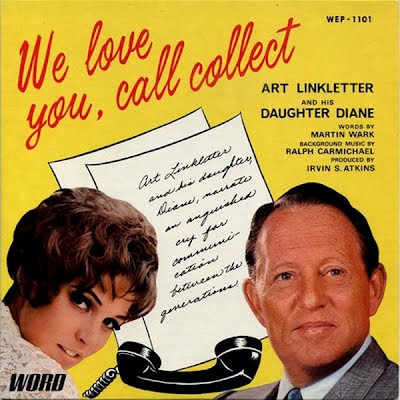
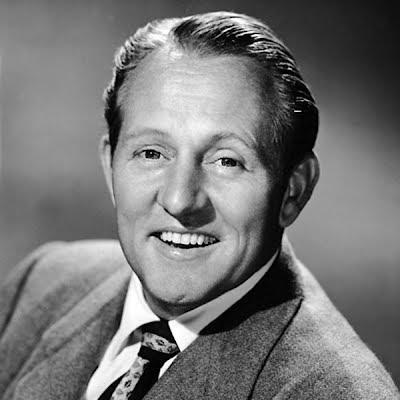

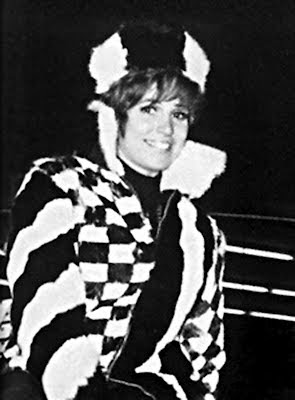
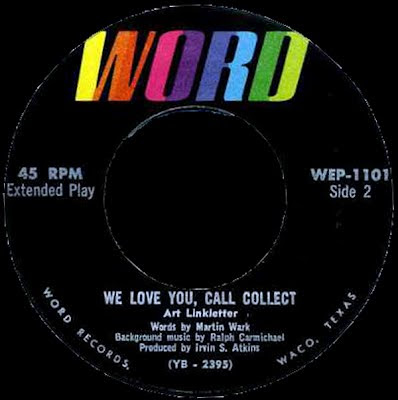
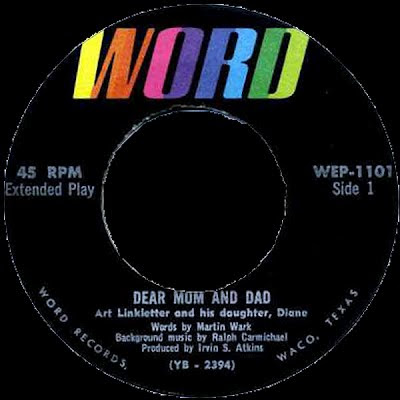
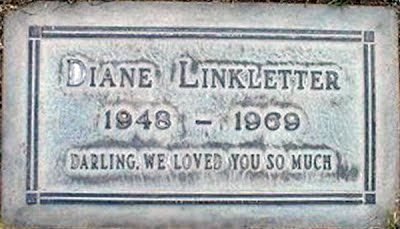
Great post about a sad mystery!
Interesting that they chose to use the past tense on her gravestone: We loved you so much.